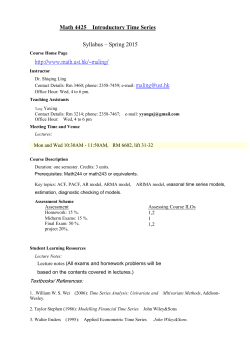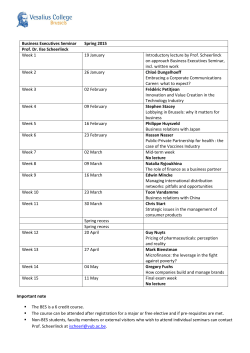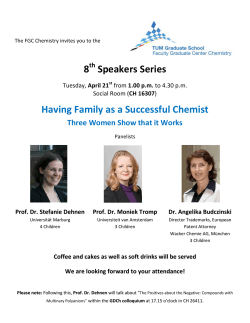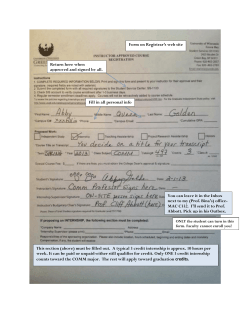
Capstone project 2015 in pdf format
A. Topics for 2-semester UG research project course (BISC) LIFS 4970/4980 (BCB) LIFS 4971/LIFS 4981 (BIOT) LIFS 4973/ LIFS 4983 Faculty name Dr. Karen Kit Yu CHAN karenchan@ust.hk Project code A001 Research topic Remarks 1: Effect of climate change related stressors on early life stage of marine invertebrate 2: Effect of microplastic on early life stage of marine invertebrate 3: Seasonal dynamic of zooplankton community in Port Shelter 4: Seasonal dynamic of carbonate chemistry of Hong Kong coastal water: implications for ocean acidification 1: Post-transcriptional regulation of muscle stem cell activation 1-2 student [A maximum of three students will be accepted] Prof. Nancy Y IP A019 A020 1: Characterization of mutants with defect in controlling DNA replication and ploidy 2: Characterization of tight junctional complex and its cytoplasmic transduction molecules 3: Genetics of fan morphogenesis by genetic screen with KC62 or derivatives 4: Verification of a global transcription factor to up and down regulation of target gene via differential DNA binding 5: Identification of interacting components in transcriptional machinery for body shape control 6: Genetic screening for mutants antagonizing BMP pathway activity in C. elegans 7: In vitro evaluation of human disease mutation of a conserved gene on its role in neural differentiation 8: Establishment of a gastropoda genetic model from molecular biology to genetics 9: Optimization of culture condition for Convolutriloba for clonal expansion 1: Characterization of familial Parkinson's disease linked gene products 1: Molecular mechanisms that regulate surface delivery of epidermal growth factor receptor 2: Molecular mechanisms that regulate surface delivery of Frizzled receptors 1: Investigating the regulation of piezoelectrical protein prestin in the outer hair cells 2: Function and Regulation of TMC1 protein in auditory hair cells 1: Pathophysiological basis of Alzheimer’s disease Dr. Toyotaka ISHIBASHI A021 1: Elucidating histone replacement mechanism in testes 1 or 2 semesters toyotaka@ust.hk Prof. Robert K M KO A022 1:Yang-invigorating action of Chinese tonic herbs bcrko@ust.hk Dr. Stanley C K LAU 2 students, BCB and BISC ONLY A023 1: Genetic and phenotypic attributes required for E. coli to grow and reproduce in marine sediment 2: Effects of microcins on the growth and reproduction of E. coli 1: Functional and quantitative PTM proteomics and cell signaling A002 A003 A004 Dr. Tom Hiu Tung CHEUNG tcheung@ust.hk Prof. King Lau CHOW bokchow@ust.hk A005 A006 A007 A008 A009 A010 A011 A012 A013 A014 Dr. Kenny K CHUNG bckchung@ust.hk Dr. Yusong GUO guoyusong@ust.hk A015 A016 A017 Dr. Pingbo HUANG bohuangp@ust.hk scklau@ust.hk Prof. Ning LI boningl@ust.hk i Dr. Chun LIANG bccliang@ust.hk Dr. Hongbin LIU liuhb@ust.hk A018 A024 A025 A026 A027 A028 A029 A030 Dr. Kai LIU kailiu@ust.hk A031 1 student 1-2 student 1 student 1 or 2 semesters BCB ONLY 1: DNA replication initiation proteins in budding yeast 2: DNA replication initiation proteins in human cells 3: Lung cancer metastasis mechanisms. 1: Effect of temperature increase on the respiration rate of auto- and heterotrophic microbial organisms 2: Effect of DOM and viruses on Achaea in estuarine and coastal waters 1: Mechanisms of the conditioning lesion effect in dorsal root ganglion neurons 1 A032 Dr. Ho Yi MAK hym@ust.hk Dr. Hyokeun PARK hkpark@ust.hk A033 A034 A035 A036 A037 A038 A039 Prof. Randy Y C POON rycpoon@ust.hk Prof. Robert Zhong QI qirz@ust.hk Prof. Peiyuan QIAN boqianpy@ust.hk Prof. Karl TSIM botsim@ust.hk A040 A041 A042 A043 1: Investigation of exocytosis of synaptic vesicles using FM 1-43 in Huntington's disease mouse model. 2: Calculation of fusion mode of single synaptic vesicles using quantum dot labelled vesicles 3. Investigation of optimal markers for mitochondria using aggregation-induced emission(AIE) 4. Measuring morphology changes of dendritic spines using fluorescent light-inducible proteins 5. Measuring movement of single synaptic vesicles in live neurons 6. Mechanism of Single Histone Methylation using Fluorescence Resonance Energy Transfer 1: Characterisation of the effects of novel ant-mitotic drug candidates on cancer cell lines 2: The role of MASTL (Greatwall kinase) in DNA damage 1: Molecular and cell biology of cytoskeletal organization A046 1: Development of secondary metabolite fingerprinting database of marine bacteria using UPLC-MS and MS-MS 1: Development of Chinese medicine as health food products in Hong Kong. 2: Quality control of Chinese herbs: chemical and biological analyses. 1: Heavy metal pollution monitoring in Pearl River Estuary. A047 1: Chromosome integrity mutants in dinoflagellates A044 A045 Prof. Wenxiong WANG wwang@ust.hk Prof. Joseph T Y WONG botin@ust.hk 2: Non-visual functions of the intrinsically photosensitive melanopsin retinal ganglion cells 1: Identification of a diet that reduces fat storage in C. elegans Description: The dinoflagellates not only have genome sizes up to 80-100 times that of human beings (up to 250 vs 3 pg of haploid genome size), they are also devoid of detectable-nucleosomes and their chromosomes are apparently quasi-condensed throughout the cell cycle. Why do they have so much DNA is still a mystery; one hypothesis of non-coding domains being “structural” support to the coding domains A048 We recently demonstrated resilience of dinoflagellates to DNA damage agents. The present project aims to isolate and characterize dinoflagellate mutants with different genome sizes. The project will involve cell biological and molecular techniques in the generation and monitoring of dinoflagellate lines. The resulting lines of dinoflagellates will help to delineate the possible loss of genomic DNA on the resulting dino-chromosomes. Students will receive training in the culture of algae, microscopy, cell biological and molecular biological techniques, which will also be involved in the characterization of the isolated mutants. 2: Minicircles – chloroplast genomes of dinoflagellates Description: Replication of organelle genomes has to be regulated in relation to the replication of the nuclear genome for faithful passage to the daughter cells. Counter to the large (>120 kb) organelle DNA found in other photosynthetic organisms, the chloroplast genomes of many dinoflagellates are found in the nuclear genome and in multiple circular DNA approximately 2 kb in sizes. Such “minicircles”, while mostly unigenic, carry from none to two open reading frames of chloroplast genes. These dinoflagellates’ minicircles probably represent the penultimate reduction of the plastid genomes, before the total integration into the nuclear genomes. We previously reported the involvement of rolling circle intermediates in the replication of minicircles. Taking advantages of semi-synchronized dinoflagellate cells, changes of minicircle dosage directly in response to a light/dark regime will be studied. How and why was the plastid genome BISC only BISC and ENVS only, up to 4 students BISC and ENVS only, up to 4 students 2 fragmented and nuclear transferred? Is it correlated with the dinoflagellate genomes being permanently condensed? How will these minicircles behave in response to inhibitors of plastid replication ? Dinoflagellates are amazing group of organisms for many other reasons: Dinoflagellates are also the primary producer of the coral reef community (as symbiotic zooxanthallae) and major causative agents of red tides and many natural products (e.g. Omega-3, Dinoflagellates are also the sister group to many major human parasites, including Plasmodium (malaria) and Toxoplasma.(Toxoplasmosis). http://wordsinmocean.com/2013/01/08/5-reasons-why-dinoflagellates -are-friggin-awesome/ Dr. Wan Keung WONG bcwkrw@ust.hk Prof. Yung Hou WONG boyung@ust.hk Prof. Zhenguo WU bczgwu@ust.hk Prof. Jun XIA jxia@ust.hk Prof. Hannah Hong XUE hxue@ust.hk Dr. Yan YAN yany@ust.hk Dr. Qinglu ZENG zeng@ust.hk Prof. Mingjie ZHANG mzhang@ust.hk Prof. Guang ZHU gzhu@ust.hk Dr. Danny Leung (New Faculty) leung.dcy@gmail.com Prof. David K BANFIELD bodkb@ust.hk Prof. David K BANFIELD bodkb@ust.hk A049 A050 A051 A052 A053 A054 A055 A056 A057 A058 A059 A060 A061 A062 A063 A064 A065 A066 A067 A068 A069 A070 A071 A072 https://www.dsm.com/markets/foodandbeverages/en_US/products/nu tritional-lipids/life-dha.html 1: Expression of valuable proteins in Escherichia coli 2: Expression of valuable proteins in Bacillus subtilis 3: Demystifying the mechanisms for intein-extein cleavages 1: Regulation of tumorigenesis by G protein signaling 2: Structure and function of Nm23 metastasis suppressors 1:The role of MST3 in muscle differentiation and muscle stem cell regulation 2: The role of PI3K in regulation of muscle stem cells 1: Protein trafficking and its role in diseases such as diabetes 2: Molecular mechanism of synapse formation, function and autism 1: GABAA receptor structure, function and genetics 2: The application of bioinformatics 3: Human Genome and diseases 1: Genetic screening for factors regulating growth control 2: Genetic screening for factors regulating tissue morphogenesis 1: Isolation of bacteriophages infecting cyanobacteria 2. Gene expression of infected cyanobacteria 1: Biochemical characterizations of gene products related to autisms and schizophrenia. 1: DNA replication at telomere 2: Structure-function of telomerase 3: Structure-function mammalian pre DNA replication complex 1: Delineating epigenetic mechanisms in melanoma 2: Discovery of active repetitive elements at specific developmental stages 1: Using yeast to study protein trafficking at the ER-Golgi interface 2: Using the regenerative flat worm (planarian) to investigate the nature of learning and memory BISC and BIOT only BCB only 1 quota and BCB only Updated on 28 May 2015 Updated on 28 May 2015 B. Topics for 1-semester Capstone course – UG Research project 2015-2016 (BISC) LIFS4960 (BCB) LIFS 4961 (BIOT) LIFS 4963 Faculty name Project code Research topic Remarks Dr. Kenny K CHUNG bckchung@ust.hk Prof. Karl HERRUP herrup@ust.hk Dr. Toyotaka ISHIBASHI B001 1 or 2 semesters B002 1: Characterization of familial Parkinson's disease linked gene products 1: Control of cell number in the brain - from conception to death B003 1: Elucidating histone replacement mechanism in testes Group project: 5 students 1 or 2 semesters 3 toyotaka@ust.hk Prof. Ning LI boningli@ust.hk B004 1: From calcium code to PTM code C. Topics for 1-semester Capstone course – UG Literature review 2015-2016 (BISC) LIFS4960 (BCB) LIFS 4961 (BIOT) LIFS 4963 Faculty name Project code Topic for Literature review Dr. Karen Kit Yu CHAN karenchan@ust.hk C001 1: Thermal tolerance of marine invertebrates: latitude difference and adaptation potential 2: Effect of hypoxia on ecological interactions 3: Size matter? Effect of size on swimming speed and fluid disturbance of zooplanktons 1: Epigenetic regulation of somatic stem cells 2: Stem cell ageing C002 C003 Dr. Tom Hiu Tung CHEUNG tcheung@ust.hk Prof. King Lau CHOW bokchow@ust.hk C004 C005 C006 C012 1: Molecular regulation of symbiosis : cross talk and gene integration, the genetics of convergence into one 2: Triparental inheritance : historical build up and practical implementation, social impact 3: Taming of the wolf : domestication and natural selection of devastating diseases 4: Selection of social behaviors : the match of environment, the adapted phenotype, the machinery and the pace of change 5: The connection of lives : human, worm, bacteria and mental disorder 6: Creation of a code : the possibility of embedded message in DNA sequence 1: Factors that contribute to neurodegenerative disorders C013 C014 C015 C016 C017 C018 1: Molecular mechanisms that regulate clathrin-mediated endocytosis 2: Organization of the Golgi apparatus 1. Development of the auditory hair cells 2. Physics of the hearing process 1: Biomarkers of neurodegeneration 1: Transcription regulation through nucleosomes C019 1: Biochemical basis of diseases C020 1: Are swimmers in public beaches in HK sufficiently protected from waterborne diseases? A critical review of the water quality monitoring methods and water quality criteria adopted by the HK government. 2: Population genetics of Escherichia coli in two highly contrasting but interconnected habitats: animal body and the external environment 1: Cancer prevention 2: Cancer therapy 1: Long term trend of seawater pH in Hong Kong waters 2: Microorganisms in ballast water (global issue or Hong Kong problem) 1: Mechanisms of the conditioning lesion effect in dorsal root ganglion neurons 2: Non-visual functions of the intrinsically photosensitive melanopsin retinal ganglion cells 1: Development of technologies for editing invertebrate genomes 2: Strategies for combating parasitic nematodes 1: Sake: history, biochemistry, and style 2: BioArt: aesthetics, techniques, and ethics C007 C008 C009 C010 C011 Dr. Kenny K CHUNG bckchung@ust.hk Dr. Yusong GUO guoyusong@ust.hk Dr. Pingbo HUANG bohuangp@ust.hk Prof. Nancy Y IP Dr. Toyotaka ISHIBASHI toyotaka@ust.hk Prof. Robert K M KO bcrko@ust.hk Dr. Stanley C K LAU scklau@ust.hk C021 Dr. Chun LIANG bccliang@ust.hk Dr. Hongbin LIU liuhb@ust.hk Dr. Kai LIU kailiu@ust.hk C022 C023 C024 C025 C026 C027 Dr. Ho Yi MAK hym@ust.hk Prof. Randy Y C POON rycpoon@ust.hk C028 C029 C030 C031 Remarks [A maximum of four students will be accepted] BCB students ONLY 2 students, BCB and BISC ONLY 4 Prof. Robert Zhong QI qirz@ust.hk Prof. Peiyuan QIAN boqianpy@ust.hk Prof. Karl TSIM botsim@ust.hk Prof. Wenxiong WANG wwang@ust.hk Prof. Zilong WEN zilong@ust.hk Prof. Joseph T Y WONG botin@ust.hk Prof. Yung Hou WONG boyung@ust.hk Prof. Zhenguo WU bczgwu@ust.hk Prof. Jun XIA jxia@ust.hk Prof. Hannah Hong XUE hxue@ust.hk Dr. Yan YAN yany@ust.hk Dr. Qinglu ZENG zeng@ust.hk Prof. Mingjie ZHANG mzhang@ust.hk Prof. Guang ZHU gzhu@ust.hk Dr. Danny Leung (New Faculty) leung.dcy@gmail.com Prof. David K BANFIELD bodkb@ust.hk C032 C033 C034 C035 1: Molecular insights into the control of human brain size 2: Functional genomics of cancer metastasis 3: Genetics and cell biology of human gender 1: Biological adaptation of deep-sea organisms to ultra-high pressure C036 C037 1: Current market for Chinese medicine in Hong Kong and China. 2: Safety of Chinese medicine: what can we do to control that in Hong Kong market. 1: heavy metal pollution in Pearl River Estuary. C038 BISC only C039 1: The development and function of regulatory T cells C040 2: The role of SCL in normal hematopoiesis and lymphoid leukemia C041 1: 5-hydroxymethyluracil in dinoflagellates C042 2: Life-history stages in dinoflagellates References Leung, S.K. and Wong, J.T.Y. (2009) The Replication of Plastid Minicircles Involves Rolling Circle Intermediates. Nucleic Acids Research 37: 1991-2002. Moreau H., Géraud M.L., Bhaud Y., Soyer-Gobillard M.O. (1998) Cloning, characterization and chromosomal localization of a repeated sequence in a dinoflagellate : Crypthecodinium cohnii Biecheler. Internatl. Microbiol.1:35-43. C043 1: Orphan G protein-coupled receptors C044 C045 C046 C047 C048 C049 C050 C051 C052 C053 C054 C055 C056 C057 C058 2: G protein-coupled receptors in liver cancer (1: Regulation of muscle regeneration by the immune system 2: Regulation of brown fat cells 1: The molecular mechanisms of learning and memory 2: Autism: gene and disease 1: Bioinformatic applications in integrated data mining 2: Chinese herbal medicine with CNS activities 3: GABAA receptor structure, function and genetics 1: Growth control during animal development 2: Tissue morphogenesis during animal development 1: Bacteriophage genomics 2. Metabolism of cyanobacteria 1: Why mutations of certain genes can cause psychiatric disorders to a selected portion of people. 1: Structure-functional study of pre DNA replication complex 2: Structure-functional study of telomere repeat binding factors C059 1: Three dimensional organization of chromatin in the nucleus. C060 2: Epigenetics in transcriptional regulation. C061 The role of the human microbiota in aging C062 The role of the Golgi in cancer development C063 The next generation of antibiotics BCB only BCB only Updated on 28 May 2015 Updated on 28 May 2015 Updated on 28 May 2015 5
© Copyright 2025









